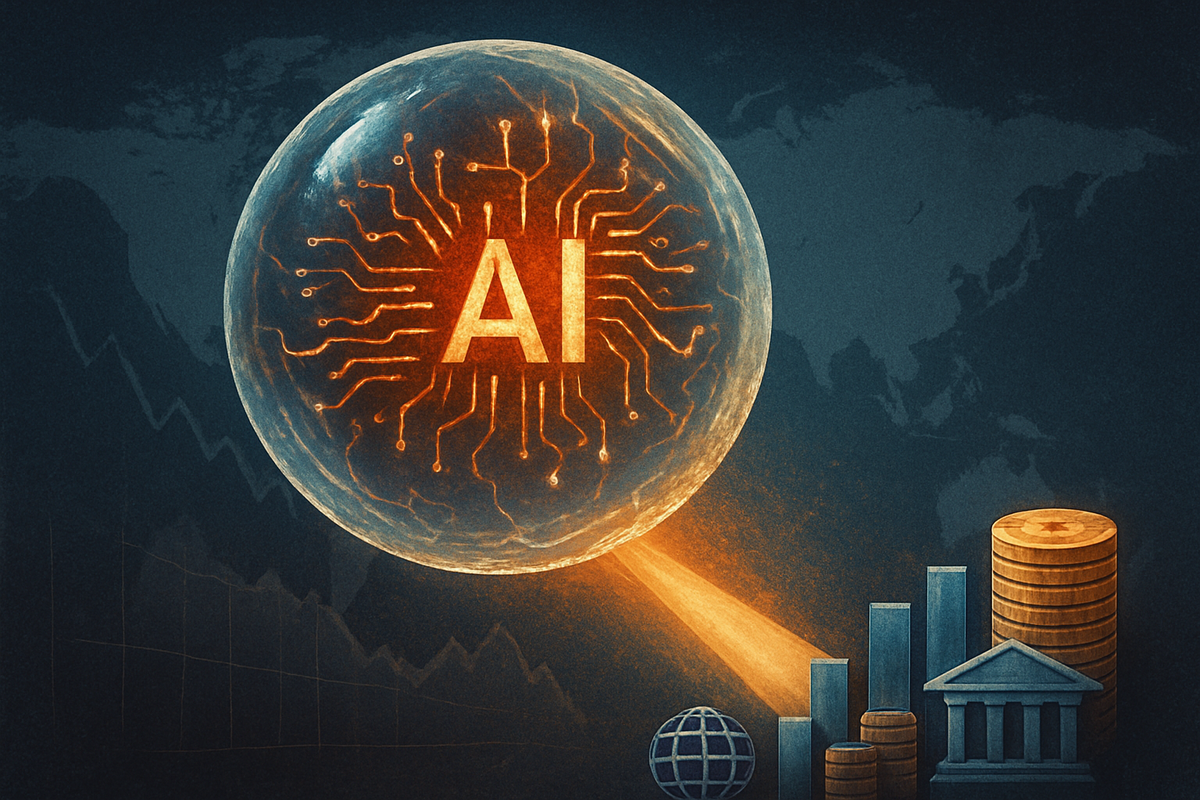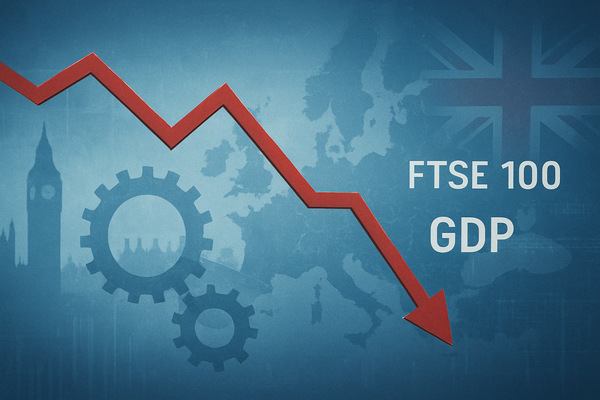The AI Bubble: Global Markets Brace for Impact as Investors Pivot to Undervalued Equities

The global financial markets are currently grappling with escalating concerns over a potential "AI bubble," a sentiment that has intensified throughout 2025 and reached a crescendo in recent weeks. As valuations for artificial intelligence-driven companies soar to unprecedented levels, a growing chorus of analysts and seasoned investors are warning of an impending market correction. This apprehension is catalyzing a significant strategic shift among some investment firms, notably highlighted in Palm Harbour Capital's Q3 2025 investor letter, towards undervalued global equities, signaling a potential recalibration of investment priorities away from speculative growth towards fundamental value.
This reorientation reflects a broader unease regarding the sustainability of current AI sector valuations, which some fear are disconnected from underlying profitability and cash flow. The shift indicates a cautious approach, with investors seeking refuge in assets with more tangible intrinsic value and less exposure to the volatile, hype-driven segments of the market. The move by firms like Palm Harbour Capital underscores a defensive posture, aiming to safeguard capital and identify resilient opportunities in a market increasingly defined by both exhilarating innovation and profound uncertainty.
The Cracks in the AI Foundation: A Detailed Look at Market Unrest
The narrative of an "AI bubble" has gained considerable traction, driven by a series of events and market indicators that suggest an unsustainable valuation surge in the AI sector. The timeline of escalating concern paints a clear picture of growing apprehension among market participants and financial institutions.
The initial tremors were felt in early 2025, following the unexpected success of the Chinese-made chatbot DeepSeek in late January. This event, surprisingly, caused a temporary dip in the stock prices of established AI companies, including a notable 17% one-day drop for Nvidia (NASDAQ: NVDA), as investors briefly questioned the monopolistic future of current market leaders. However, the broader AI rally quickly resumed, pushing valuations even higher. By October 2025, the warnings grew more strident. "Bubble graphics" depicting circular investments within the AI ecosystem began circulating widely, illustrating a perceived self-reinforcing valuation cycle. The Bank of England issued a stark warning about the increasing risks of a global market correction, citing the potential overvaluation of leading AI tech firms. OpenAI, for instance, saw its valuation more than triple from $157 billion in October 2024 to an astonishing $500 billion a year later. The Harvard Business Review, Yale, and the Brookings Institution also weighed in during October and November 2025, highlighting concerns over distorted market expectations fueled by investments like Nvidia's reported $100 billion commitment to OpenAI and reciprocal chip purchases, alongside broader overvaluations and circular financing risks.
The climax of these concerns arrived in early November 2025, as global stock markets, encompassing the US, Asia, and Europe, experienced sharp declines directly attributed to fears of an AI bubble bursting. Prominent bank bosses, including those from Morgan Stanley (NYSE: MS) and Goldman Sachs (NYSE: GS), publicly cautioned about a serious stock market correction. Legendary investor Mark Mobius went further, predicting a potential 40% stock drop due to what he termed "frothy valuations" and excessive AI spending. The "Magnificent Seven" AI-related stocks—Nvidia (NASDAQ: NVDA), Amazon (NASDAQ: AMZN), Apple (NASDAQ: AAPL), Microsoft (NASDAQ: MSFT), Tesla (NASDAQ: TSLA), Alphabet (NASDAQ: GOOGL), and Meta (NASDAQ: META)—all experienced significant one-day falls. Notably, short-seller Michael Burry targeted Nvidia and Palantir Technologies (NYSE: PLTR), further fueling bearish sentiment. Palantir, despite beating earnings expectations and raising guidance in November 2025, saw its stock decline by 8% as investors reassessed its staggering 700x earnings multiple. AMD's (NASDAQ: AMD) stock also fell post-market results. The broader market reaction included declines in S&P 500 futures and Nasdaq 100, with Bitcoin briefly dipping below $100,000, indicating a widespread withdrawal from riskier assets amidst economic outlook fears.
Navigating the Volatility: Potential Winners and Losers in a Shifting Landscape
The unfolding scenario around the AI bubble has clear implications for public companies, creating a distinct divide between potential winners and losers as market dynamics shift from speculative growth to fundamental value.
The most immediate "losers" are likely to be companies whose valuations are heavily inflated by AI hype, exhibiting extreme price-to-earnings (P/E) ratios and questionable profitability. Companies like Palantir Technologies (NYSE: PLTR), despite its operational successes, saw its stock decline due to its 700x earnings multiple being deemed unsustainable. Other AI tech firms relying on circular financing or lacking robust cash flows could face significant downward pressure as investors scrutinize their fundamentals. Many of the "Magnificent Seven" (Amazon (NASDAQ: AMZN), Apple (NASDAQ: AAPL), Microsoft (NASDAQ: MSFT), Tesla (NASDAQ: TSLA), Alphabet (NASDAQ: GOOGL), Meta (NASDAQ: META), and Nvidia (NASDAQ: NVDA)), while fundamentally strong, could experience further volatility if their AI-driven growth premiums are re-evaluated. Their high concentration in major indices also poses a systemic risk if their valuations correct sharply.
Conversely, the "winners" in this environment are poised to be undervalued global equities—companies with solid fundamentals, consistent profitability, and modest valuations that have been overlooked during the AI-driven growth frenzy. Investment firms like Palm Harbour Capital, which consistently focus on value investing, are strategically positioning themselves to capitalize on this shift. Their Q3 2025 investor letter, though not fully detailed in public records, is expected to reiterate their strategy of finding "abundant opportunities across the globe in overlooked securities," particularly global small caps at low valuations. Regions like Europe, especially the UK, are highlighted as attractive developed markets due to rising GDP, falling inflation, and lower interest rates, with equities trading at an estimated 5% discount to fair value. European small-cap companies are seen as offering "significantly greater value" at a hefty 40% discount. Emerging markets and Asia, including Hong Kong and mainland China, are also attracting renewed interest due to appearing value opportunities and meaningful valuation discounts. Companies in these regions, less exposed to the AI valuation frenzy, are likely to attract capital from investors seeking stability and long-term growth based on intrinsic worth.
A Broader Canvas: Understanding the Wider Significance of the AI Market Correction
The concerns surrounding an AI bubble and the subsequent strategic pivot by investors represent more than just a sector-specific adjustment; they signify a potentially profound recalibration of broader industry trends and investment philosophies. This event fits into a wider shift away from an unbridled pursuit of growth at any cost towards a renewed emphasis on value, profitability, and sustainable business models.
The potential ripple effects extend far beyond the immediate tech sector. Venture capital funding for AI startups, which has enjoyed a period of exuberance, could face increased scrutiny and a more cautious allocation of capital. Competitors and partners of highly valued AI firms may also feel the squeeze, either through reduced investment opportunities or a reassessment of their own strategic alliances. The intense market concentration, with single companies representing as much as 8% of major indices, means that a significant correction in these bellwether AI stocks could have a cascading effect across the entire market, impacting diversified portfolios and pension funds. Regulatory or policy implications are also on the horizon. The concerns over "circular financing" and artificial valuation inflation could prompt increased oversight from financial regulators, potentially leading to new guidelines or enforcement actions aimed at ensuring market transparency and integrity. Historically, this situation bears striking resemblances to the dot-com bubble of the late 1990s and early 2000s. The Case-Shiller price-to-earnings ratio for the US market recently exceeded 40 for the first time since that crash, serving as a stark historical precedent. Like the dot-com era, the current environment is characterized by groundbreaking technological innovation intertwined with speculative investment, leading to valuations that defy traditional metrics. The lessons from that period – the eventual collapse of many overhyped companies and the triumph of those with solid business models – offer a crucial lens through which to view the current market.
The Road Ahead: Navigating Short-Term Volatility and Long-Term Opportunities
As global markets grapple with the implications of a potential AI bubble, the path forward presents both significant challenges and compelling opportunities for investors. The immediate future is likely to be characterized by continued volatility, particularly in the highly-valued technology sector.
In the short-term, investors should anticipate further corrections in overvalued AI stocks as market participants continue to re-evaluate earnings multiples and growth projections against a backdrop of increasing caution. This period of repricing may lead to further market turbulence and could test the resilience of investor portfolios. Companies that have relied heavily on speculative capital or lack clear paths to profitability will face considerable headwinds. Conversely, this volatility could create attractive entry points for long-term investors looking to acquire quality AI assets at more reasonable valuations, provided they possess strong fundamentals and a sustainable competitive advantage.
Looking at the long-term, the market is likely to evolve towards a more balanced landscape. The strategic pivot towards undervalued global equities, as exemplified by Palm Harbour Capital, suggests a sustained focus on fundamental analysis and a greater appreciation for diversified portfolios. This could lead to a broader distribution of capital across different sectors and geographies, moving away from the concentrated dominance of a few tech giants. Market opportunities will emerge in regions and sectors that have been historically overlooked, such as Europe's developed markets and various emerging markets in Asia and Latin America, where valuation discounts are significant. Small-cap companies, particularly in these undervalued regions, could offer substantial growth potential as investors seek out hidden gems. However, the primary challenge will be accurately identifying true value amidst ongoing market noise and distinguishing between genuine innovation and mere hype. Strategic pivots or adaptations required from companies might include a renewed focus on profitability, cost efficiency, and demonstrating clear returns on AI investments rather than just technological advancements. Potential scenarios range from a gradual deflation of the AI bubble, leading to a soft landing for the broader market, to a more abrupt and significant correction, which could trigger wider economic concerns.
A New Era of Investment: Key Takeaways and Future Outlook
The current discourse around an "AI bubble" and the subsequent strategic shift by investors marks a pivotal moment in the global financial markets. The key takeaway is clear: the era of unbridled, speculative growth driven solely by technological promise is facing a serious reality check. Market participants are increasingly prioritizing tangible value, robust fundamentals, and diversified exposure over the allure of exponential, yet potentially unsustainable, returns from highly concentrated tech investments.
Moving forward, the market is poised for a continued re-evaluation of technology valuations. This does not necessarily signal a repudiation of AI's transformative potential, but rather a more discerning approach to its investment implications. Investors should expect heightened scrutiny of profitability, cash flow generation, and sustainable business models within the AI sector. The increased focus on geographical diversification, with a notable rotation into undervalued markets in Europe, emerging economies, and parts of Asia, indicates a broader quest for resilience and uncorrelated returns in an increasingly interconnected yet fragmented global economy. This shift underscores a renewed appreciation for "portfolio insurance" through strategic asset allocation.
The lasting impact of this period could be a fundamental reset in how growth and innovation are valued across industries. It may usher in a new era where fundamental analysis regains its prominence, and prudent risk management becomes paramount. What investors should watch for in the coming months includes further earnings reports from key AI players, any shifts in central bank interest rate policies, evolving geopolitical developments that could impact global supply chains and market sentiment, and sustained signs of capital rotation into value-oriented segments. The ability to identify genuinely transformative companies with strong underlying economics, regardless of their sector, will be crucial for navigating this evolving landscape.
This content is intended for informational purposes only and is not financial advice



